Related Research Articles

Ambrose of Milan, venerated as Saint Ambrose, was a theologian and statesman who served as Bishop of Milan from 374 to 397. He expressed himself prominently as a public figure, fiercely promoting Roman Christianity against Arianism and paganism. He left a substantial collection of writings, of which the best known include the ethical commentary De officiis ministrorum (377–391), and the exegetical Exameron (386–390). His preaching, his actions and his literary works, in addition to his innovative musical hymnography, made him one of the most influential ecclesiastical figures of the 4th century.
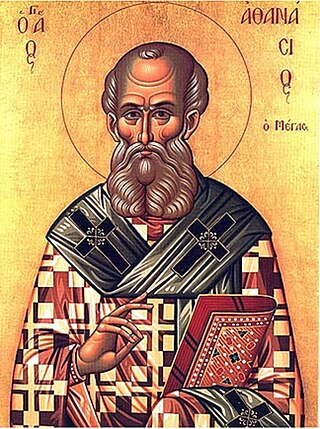
Athanasius I of Alexandria, also called Athanasius the Great, Athanasius the Confessor, or, among Coptic Christians, Athanasius the Apostolic, was a Christian theologian and the 20th pope of Alexandria. His intermittent episcopacy spanned 45 years, of which over 17 encompassed five exiles, when he was replaced on the order of four different Roman emperors. Athanasius was a Church Father, the chief proponent of Trinitarianism against Arianism, and a noted Egyptian Christian leader of the fourth century.
Eusebius of Caesarea, also known as Eusebius Pamphilius, was a Greek Syro-Palestinian historian of Christianity, exegete, and Christian polemicist. In about AD 314 he became the bishop of Caesarea Maritima in the Roman province of Syria Palaestina.

The First Council of Nicaea was a council of Christian bishops convened in the Bithynian city of Nicaea by the Roman Emperor Constantine I. The Council of Nicaea met from May until the end of July 325.
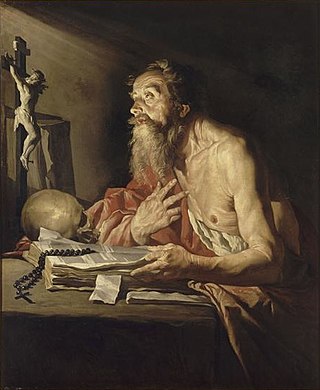
Jerome, also known as Jerome of Stridon, was an early Christian priest, confessor, theologian, translator, and historian; he is commonly known as Saint Jerome.

Polycarp was a Christian bishop of Smyrna. According to the Martyrdom of Polycarp, he died a martyr, bound and burned at the stake, then stabbed when the fire failed to consume his body. Polycarp is regarded as a saint and Church Father in the Eastern Orthodox Church, Roman Catholic Church, Oriental Orthodox Churches, Lutheranism, and Anglicanism.
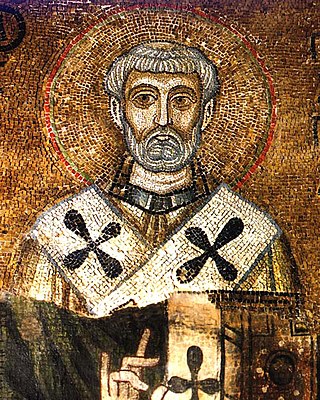
Clement of Rome, also known as Pope Clement I, was the bishop of Rome in the late first century AD. He is considered to be the first of the Apostolic Fathers of the Church, and a leading member of the Church in Rome in the late 1st century.

Hilary of Poitiers was Bishop of Poitiers and a Doctor of the Church. He was sometimes referred to as the "Hammer of the Arians" and the "Athanasius of the West". His name comes from the Latin word for happy or cheerful. In addition to his important work as bishop, Hilary was married and the father of Abra of Poitiers, a nun and saint who became known for her charity.
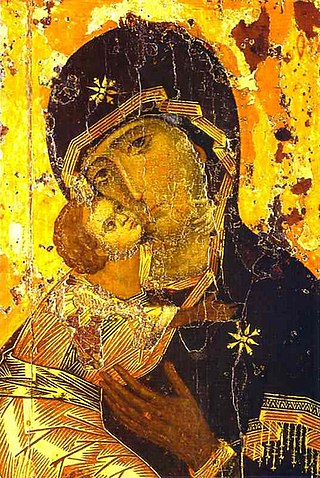
The perpetual virginity of Mary is a Christian doctrine that Mary, the mother of Jesus, was a virgin "before, during and after" the birth of Christ. In Western Christianity, the Catholic Church adheres to the doctrine, as do some Lutherans, Anglicans, Reformed, and other Protestants. In Eastern Christianity, the Oriental Orthodox Churches and the Church of the East both adhere to this doctrine as part of their ongoing tradition, and Eastern Orthodox churches recognize Mary as Aeiparthenos, meaning "ever-virgin". It is one of the four Marian dogmas of the Catholic Church. Most modern nonconformist Protestants reject the doctrine.

Jovinian was an opponent of Christian asceticism in the 4th century and was condemned as a heretic at synods convened in Rome under Pope Siricius and in Milan by Ambrose in 393 because of his views. Our information about him is derived principally from the work of Jerome in two books, Adversus Jovinianum. Jerome referred to him as the "Epicurus of Christianity". He was a native of Corduene, in present day Turkey. John Henry Newman called Aerius of Sebaste, Jovinian and Vigilantius the forerunners of Protestantism, likening them to the "Luther, Calvin, and Zwingli of the fourth century". Other Protestants also praise Jovinian as an early reformer or even credit him as the "first Protestant". Jovinian's teachings received much popular support in Rome and Milan and his followers Sarmatio and Barbatianus kept preaching his ideas after Jovinian was expelled.

St. Lucifer of Cagliari was a bishop of Cagliari in Sardinia known for his passionate opposition to Arianism. He is venerated as a Saint in Sardinia.
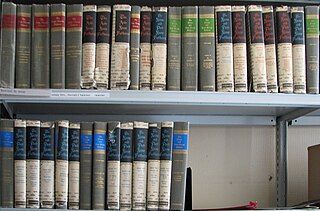
Patristics or patrology is the study of the early Christian writers who are designated Church Fathers. The names derive from the combined forms of Latin pater and Greek πᾰτήρ (father). The period of the Church Fathers, commonly called the Patristic era, is generally considered to run from the end of New Testament times or end of the Apostolic Age to either AD 451 or to the Second Council of Nicaea in 787.

Paula of Rome was an ancient Roman Christian saint and early Desert Mother. A member of one of the richest senatorial families which claimed descent from Agamemnon, Paula was the daughter of Blesilla and Rogatus, from the great clan of the Furii Camilli. At the age of 16, Paula was married to the nobleman Toxotius, with whom she had four daughters, Blaesilla, Paulina, Eustochium, and Rufina. She also had a boy, also named Toxotius. As a disciple of Jerome, she is considered the first nun in the history of Christianity.

Jovinianism refers to an anti-ascetic movement that has its origins in the 4th-century theologian Jovinian, who criticized the monastic movement and argued for the equality of marriage and celibacy. Jovinianism was criticized by Saint Augustine and Jerome.
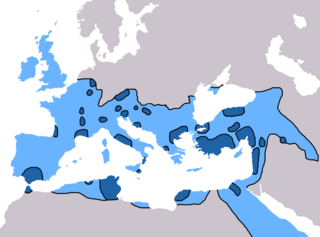
Christianity in the 4th century was dominated in its early stage by Constantine the Great and the First Council of Nicaea of 325, which was the beginning of the period of the First seven Ecumenical Councils (325–787), and in its late stage by the Edict of Thessalonica of 380, which made Nicene Christianity the state church of the Roman Empire.

In the 5th century in Christianity, there were many developments which led to further fracturing of the State church of the Roman Empire. Emperor Theodosius II called two synods in Ephesus, one in 431 and one in 449, that addressed the teachings of Patriarch of Constantinople Nestorius and similar teachings. Nestorius had taught that Christ's divine and human nature were distinct persons, and hence Mary was the mother of Christ but not the mother of God. The Council rejected Nestorius' view causing many churches, centered on the School of Edessa, to a Nestorian break with the imperial church. Persecuted within the Roman Empire, many Nestorians fled to Persia and joined the Sassanid Church thereby making it a center of Nestorianism. By the end of the 5th century, the global Christian population was estimated at 10-11 million. In 451 the Council of Chalcedon was held to clarify the issue further. The council ultimately stated that Christ's divine and human nature were separate but both part of a single entity, a viewpoint rejected by many churches who called themselves miaphysites. The resulting schism created a communion of churches, including the Armenian, Syrian, and Egyptian churches, that is today known as Oriental Orthodoxy. In spite of these schisms, however, the imperial church still came to represent the majority of Christians within the Roman Empire.

Christianity in late antiquity traces Christianity during the Christian Roman Empire — the period from the rise of Christianity under Emperor Constantine, until the fall of the Western Roman Empire. The end-date of this period varies because the transition to the sub-Roman period occurred gradually and at different times in different areas. One may generally date late ancient Christianity as lasting to the late 6th century and the re-conquests under Justinian of the Byzantine Empire, though a more traditional end-date is 476, the year in which Odoacer deposed Romulus Augustus, traditionally considered the last western emperor.

The Church Fathers, Early Church Fathers, Christian Fathers, or Fathers of the Church were ancient and influential Christian theologians and writers who established the intellectual and doctrinal foundations of Christianity. The historical period in which they worked became known as the Patristic Era and spans approximately from the late 1st to mid-8th centuries, flourishing in particular during the 4th and 5th centuries, when Christianity was in the process of establishing itself as the state church of the Roman Empire.
Sarmatio was a 4th-century monk in Milan and a disciple of Jovinian, who disputed the merits of the monastic and unmarried life. Sarmatio first met Jovinian when he travelled to Milan, where Jovinian found two monks of a similar mind, Sarmatio and Barbatianus. After Jovinian was expelled from Milan, Sarmatio kept doing work in Vercellae where he gathered a considerable following and public support; in response, Ambrose, the bishop of Milan, started defending ascetism. The views Sarmatio was preaching were condemned in the Synod of Milan.
References
- ↑ Neander, August (1848). General History of the Christian Religion and Church: From the German of Dr. Augustus Neander. Crocker & Brewster.
- ↑ Kurtz, J. H. (2020-12-17). The History of Church: All 3 Volumes. e-artnow.
- ↑ Jerome; Jerome, St St (2010). Commentary on Galatians. CUA Press. ISBN 978-0-8132-0121-4.
- ↑ "Philip Schaff: History of the Christian Church, Volume III: Nicene and Post-Nicene Christianity. A.D. 311-600 - Christian Classics Ethereal Library". www.ccel.org. Retrieved 2022-06-18.
- ↑ Peter, Allix. The Ecclesiastical History of the Ancient Churches of the Albigenses. Delmarva Publications, Inc.
- ↑ Hunter, David G. (2007-01-26). Marriage, Celibacy, and Heresy in Ancient Christianity: The Jovinianist Controversy. OUP Oxford. ISBN 978-0-19-153553-6.
- ↑ "CHURCH FATHERS: Letter 63 (Ambrose)". www.newadvent.org. Retrieved 2022-06-18.
- ↑ S.J, Brian E. Daley; Kolbet, Paul R. (2015-01-30). The Harp of Prophecy: Early Christian Interpretation of the Psalms. University of Notre Dame Press. ISBN 978-0-268-15831-6.